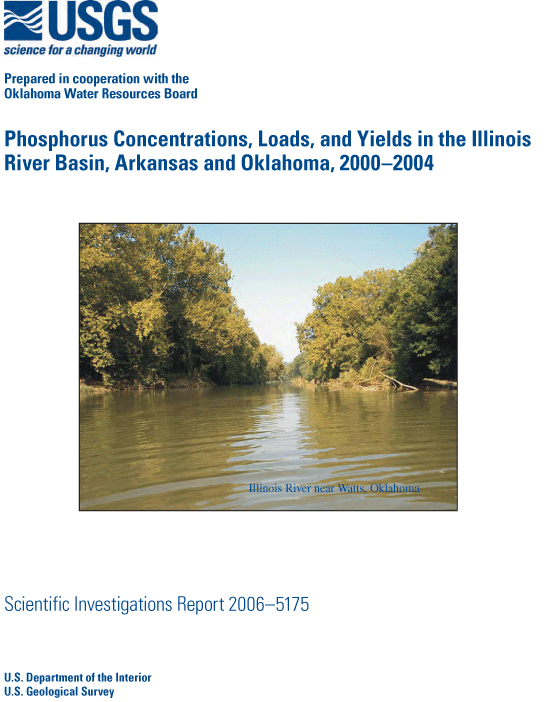 |
|
|
||||
| Oklahoma Water Science Center |
U.S. GEOLOGICAL SURVEY
Scientific Investigation Report 2006-5175
 |
The Illinois River and tributaries, Flint Creek and Baron Fork, are designated scenic rivers in Oklahoma. Recent phosphorus levels in streams in the basin have resulted in the growth of excess algae, which have limited the aesthetic benefits of water bodies in the basin, especially the Illinois River and Lake Tenkiller. The Oklahoma Water Resources Board has established a standard for total phosphorus not to exceed the 30-day geometric mean concentration of 0.037 milligram per liter in Oklahoma Scenic Rivers. The U.S. Geological Survey, in cooperation with the Oklahoma Water Resources Board, conducted an investigation to summarize phosphorus concentrations and provide estimates of phosphorus loads, yields, and flow-weighted concentrations in the Illinois River and tributaries from January 2000 through December 2004. Data from water-quality samples collected from 2000 to 2004 were used to summarize phosphorus concentrations and estimate phosphorus loads, yields, and mean flow-weighted concentrations in the Illinois River basin for three 3-year periods20002002, 20012003, and 20022004, to update a previous report that used data from water-quality samples from 1997 to 2001. This report provides information needed to advance knowledge of the regional hydrologic system and understanding of hydrologic processes, and provides hydrologic data and results useful to multiple parties for interstate compacts.
Phosphorus concentrations in the Illinois River basin were significantly greater in runoff samples than in base-flow samples. Phosphorus concentrations generally decreased with increasing base flow, from dilution, and decreased in the downstream direction in the Illinois River from the Watts to Tahlequah stations. Phosphorus concentrations generally increased with runoff, possibly because of phosphorus resuspension, stream bank erosion, and the addition of phosphorus from nonpoint sources.
Estimated mean annual phosphorus loads were greater at the Illinois River stations than at Flint Creek and Baron Fork. Annual total loads in the Illinois River from Watts to Tahlequah, increased slightly for the period 20002002 and decreased slightly for the periods 20012003 and 20022004. Estimated mean annual base-flow loads at stations on the Illinois River were about 11 to 20 times greater than base-flow loads at the station on Baron Fork and 4 to 10 times greater than base-flow loads at the station on Flint Creek. Estimated mean annual runoff loads ranged from 68 to 96 percent of the estimated mean annual total phosphorus loads from 20002004. Estimated mean seasonal base-flow loads were generally greatest in spring (March through May) and were least in fall (September through November). Estimated mean seasonal runoff loads generally were greatest in summer (June through August) for the period 20002002, but were greatest in winter (December through February) for the period 20012003, and greatest in spring for the period 20022004.
Estimated mean total yields of phosphorus ranged from 192 to 811 pounds per year per square mile, with greatest yields being reported for Illinois River near Watts (576 to 811 pounds per year per square mile), and the least yields being reported for Baron Fork at Eldon for the periods 20002002 and 20012003 (501 and 192 pounds per year per square mile) and for Illinois River near Tahlequah for the period 20022004 (370 pounds per year per square mile). Estimated mean flow-weighted concentrations were more than 10 times greater than the median (0.022 milligram per liter) and were consistently greater than the 75th percentile of flow-weighted phosphorus concentrations in samples collected at relatively undeveloped basins of the United States (0.037 milligram per liter). In addition, flow-weighted phosphorus concentrations in 20002002 at all Illinois River stations and at Flint Creek near Kansas were equal to or greater than the 75th percentile of all National Water-Quality Assessment Program stations in the United States (0.29 milligram per liter).
The estimated mean annual phosphorus load entering Lake Tenkiller ranged from about 391,000 pounds per year to 712,000 pounds per year, and from about 83 to 90 percent of the load was transported to the lake by runoff.
Abstract
Introduction
Purpose and Scope
Study Area Description
Streamflow in the Illinois River Basin
Acknowledgments
Methods
Water-Quality Data Collection and Analysis
Streamflow Separation
Statistical Tests
Load and Yield Estimation
Phosphorus Concentrations, Loads, and Yields in the Illinois River Basin
Concentrations
Estimated Mean Annual Loads
Estimated Mean Seasonal Loads
Estimated Mean Yields
Estimated Mean Flow-Weighted Concentrations
Estimated Mean Annual Phosphorus Loads into Lake Tenkiller
Summary
Selected References
Appendixes
This report is available online in Portable Document Format (PDF). If you do not have the Adobe Acrobat PDF Reader, it is available for free download from Adobe Systems Incorporated.
View the full report in PDF (1.4 MB)
Document Accessibility: Adobe Systems Incorporated has information about PDFs and the visually impaired. This information provides tools to help make PDF files accessible. These tools and the accessible reader may be obtained free from Adobe at Adobe Access.
For more information about USGS activities in Oklahoma contact:
Director
Oklahoma Water Science Center
U.S. Geological Survey
202 NW 66th Street, Bldg. 7
Oklahoma City, OK 73116
Telephone: (405) 810-4400
Fax: (405) 843-7712
or access the USGS Water Resources of Oklahoma home page at: http://ok.water.usgs.gov/.
Information: GS-W-OK_Webmaster@usgs.gov